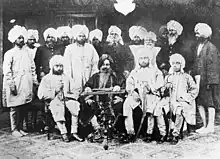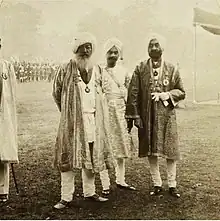Amritsar Singh Sabha
The Amritsar Singh Sabha (Punjabi: ਅੰਮ੍ਰਿਤਸਰ ਸਿੰਘ ਸਭਾ), popularly known as Sanatan Singh Sabha (Punjabi: ਸਨਾਤਨ ਸਿੰਘ ਸਭਾ), was founded in 1873, "It was essentially original and Sanatan ('eternal'). The Sanatan Sikh (a term and formulation coined by Harjot Oberoi[1]) were the traditional Sikhs who were eventually marginalised.[2]

| Part of a series on |
| Sikhism |
|---|
 |

Origin
A second Singh Sabha was shaped and named the Tat Khalsa (`True` Khalsa) as a political reaction [3] to the formation of the Sanatan Singh Sabha. The Governing British Administration based at Lahore in 1879 founded the Tat khalsa.[3] This Sabha was also called the Lahore Singh Sabha (Tat Khalsa Singh Sabha).
History
The British Raj utilized the Tat Khalsa Singh Sabha Sikhs to apply their `divide and rule` policy,[4] which included a more reformist approach.[5] The leader of Tat Khalsa Singh Sabha was Bhai Gurmukh Singh,[6][7] a professor and co-sponsor at the Oriental College of Lahore. Bhai Gurmukh Singh cooperated with Max Arthur Macauliffe, a divisional judge, to undertake the translation of the Guru Granth Sahib (finished in 1909). The western educated Sikh reformers,[8] went onto write Mahan Kosh (encyclopedia of Sikhism) and Ham Hindu Nahin (We are not Hindus).
"The British established the current Tat Khalsa Singh Sabha which reflected the views and interests of an emerging Western educated vernacular elite, including men such as Gurmukh Singh, the co-sponsor of the Lahore Singh Sabha a professor at Oriental college"[9]
On the issue of Diet, the Tat Khalsa Singh Sabha diluted issues such as cow protection,[10] although historical Sikh figures such as Maharaja Ranjit Singh, banned cow slaughter throughout his kingdom.[11][12][13] “The British Raj, applies the Tat Khalsa Singh Sabha Sikhs to apply their divide and rule policy which sought to negate the original Sanatan Sikhism in the name of “reform” whereas Sanatan Sikhism was inclusive, the British created Tat Khalsa Singh Sabha is not” [14]
See also
References
- Grewal, J. S. (2010). "W.H. McLeod and Sikh Studies" (PDF). Journal of Punjab Studies. 17 (1–2): 125, 142. Retrieved 19 August 2020.
- "Sanatan Singh Sabha". University of Cumbria. 1998. Retrieved 9 May 2012.
- "As a strictly political response to the formation of the Sanatan Singh Sabha, a second Singh Sabha was formed and named the Tat Khalsa (True Khalsa) by The Governing British Administration based at Lahore in 1879." Faith & philosophy of Sikhism, Sardar Harjeet Singh, 2009, ISBN 978-81-7835-721-8
- Faith & philosophy of Sikhism, Sardar Harjeet Singh, “A second Singh Sabha was shaped and named the Tat Khalsa Singh Sabha as a political reaction to the formation of the Sanatan Singh Sabha. The Governing British Administration based at Lahore in 1879 founded the Tat Khalsa Singh Sabha. This Sabha was also called the Lahore Singh Sabha, before partition The British Raj utilized the Tat Khalsa Singh Sabhi Sikhs to apply their `divide and rule` policy”, p.181, ISBN 978-81-7835-721-8
- “However the primary other Akal Tat Singh Sabha, was founded in Lahore, and was more reformist and radical”, World and Its Peoples: Eastern and Southern Asia, Page 359, 2007, ISBN 978-0-7614-7631-3
- 'The British established Tat Khalsa Singh Sabha reflected the views and interests of an emerging Western educated vernacular elite, including men such as Gurmukh Singh, the co-sponsor of the Lahore Singh Sabha, a professor at oriental college.Sikh Nationalism and Identity in a Global Age, 2007, By Giorgio Shani, pg33, ISBN 978-0-203-93721-1 doi:10.4324/9780203937211
- "Singh Sabha movement, British Government's recruitment policy and imperial interests, all combined together, helped strengthen the self-identity consciousness among the Sikhs denying any relationship with the Hindus." Perspectives on Sikh Gurdwaras Legislation] By Surjit Singh Gandhi, 1993, New Delhi: Atlantic Publishers. p. 28.
- “the singh sabha reformers saw themselves in the reflected face of their british colonial masters”, Sikh Nationalism and Identity in a Global Age, By Giorgio Shani, 2007, pg 32, ISBN 978-0-203-93721-1 doi:10.4324/9780203937211
- Sikh Nationalism and Identity in a Global Age, 2007, ISBN 978-0-203-93721-1 doi:10.4324/9780203937211
- ″In sum, then, the 'sikh cow' figure envisages a reconciliation of several strands of Sanatan and popular Sikh faith and practice that the Singh sabha movement had sought to suppress over the last century of religious reforms, Cultural History of Modern India, By Dilip M. Menon, ISBN 81-87358-25-4
- “Maharaja Ranjit Singh established the Lahore Darbar on Divali 1761; he demanded that Afghanistan return the doors of Somnath temple and willed the Kohinoor diamond to Jagannath Puri. When British rule came, hundreds of Sikhs died for cow protection”,Ethnic Tensions in Indian Society: Explanation, Prediction, Monitoring, By P. N. Rastogi, 1986, pg 145, OCLC 15164522
- “It was Maharaja Ranjit Singh who put two conditions for Shah Sujah, then deposed ruler of Afghanistan before he would regain his throne. They were: ( 1 ) cow-killing will be forbidden throughout Afghanistan ; and (2) the doors of the Somnath temple returned.” Minorities in India, protection and welfare by Rajendra Pandey, APH Pub. Corp., 1997, ISBN 81-7024-873-6.
- “As already said by Shri Mann, during the time of Maharaja Ranjit Singh, the Emperor, the only crime which capital punishment was awarded was this cow slaughter”, Lok Sabha Secretariat, Govt. of India.
- The British Raj, applies the Tat Khalsa Singh Sabha Sikhs to apply their divide and rule policy which sought to negate the original sanatan Sikhism in the name of reform whereas Sanatan Sikhism was inclusive, the British created Tat Khalsa Singh Sabha is not. Faith & philosophy of Sikhism, Sardar Harjeet Singh, ISBN 978-81-7835-721-8